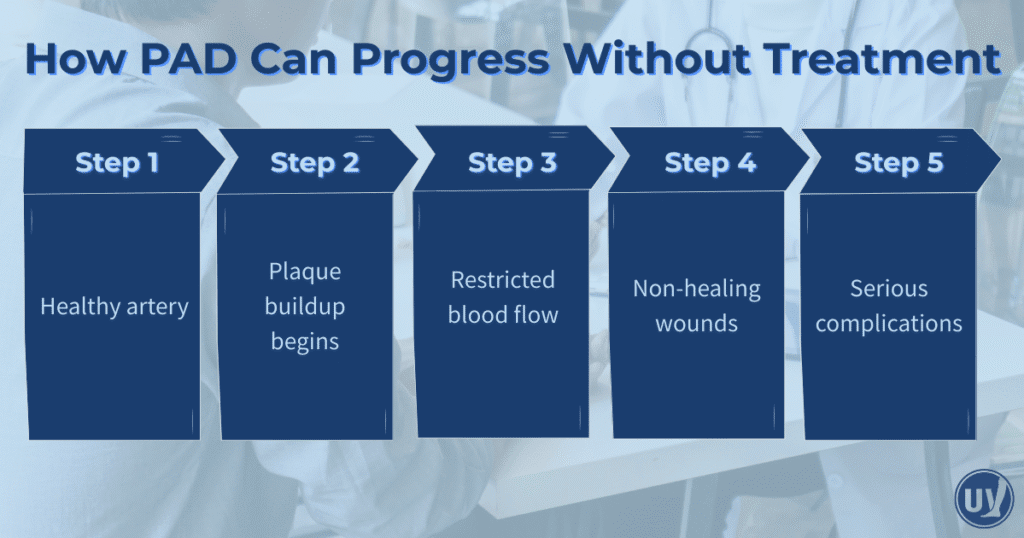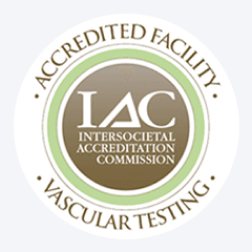Peripheral artery disease (PAD) is a serious yet common circulatory condition that affects millions of people in the United States and around the world. It develops when the arteries that supply blood to the legs and feet become narrowed or blocked due to plaque buildup. This buildup, made of cholesterol, fatty substances, and other deposits, restricts blood flow and places extra strain on your vascular system. The result is often discomfort, pain, cramping, or even wounds that struggle to heal.
PAD is closely related to heart disease and shares many of the same risk factors, including smoking, diabetes, high blood pressure, and high cholesterol. While there is currently no cure for PAD, the encouraging news is that there are effective treatment options available. At United Vein & Vascular Centers, we specialize in comprehensive PAD management strategies that can help improve circulation, reduce symptoms, and prevent serious complications.
If you are living with PAD or suspect you may have it, understanding your treatment options is the first step in taking control of your vascular health.
Why Treatment for PAD Matters
PAD is not just a condition that causes discomfort in your legs. Left untreated, it can have life-altering consequences. Reduced circulation raises the risk of non-healing wounds, infections, and even amputation in severe cases. PAD is also a warning sign of widespread arterial disease, which increases your likelihood of having a heart attack or stroke.
The earlier PAD is diagnosed and treated, the better the outcomes. With a proactive approach, many people are able to restore their mobility, maintain independence, and significantly improve their quality of life.
Personalized Care at United Vein & Vascular Centers
No two patients with PAD are the same, which is why treatment must be tailored to each individual. At United Vein & Vascular Centers, our experienced specialists create personalized treatment plans based on your overall health, the severity of your condition, and your lifestyle goals.
Your plan may include a combination of lifestyle adjustments, medications, and advanced minimally invasive procedures. The goal is always the same: to restore blood flow, reduce symptoms, and protect you from future complications.
Lifestyle Modifications: Building a Healthier Foundation
Lifestyle changes are considered the cornerstone of PAD management. Even small adjustments can make a meaningful difference in improving circulation and slowing the progression of the disease. Some of the most impactful changes include:
Quitting Smoking
Smoking is one of the strongest risk factors for PAD. Chemicals in tobacco damage the lining of your arteries, promote plaque buildup, and reduce oxygen levels in your blood. Quitting smoking is the single most powerful step you can take to improve your circulation and reduce your risk of PAD-related complications.
Adopting a Heart-Healthy Diet
What you eat directly affects your arteries. A diet rich in fresh fruits, vegetables, whole grains, lean proteins, and healthy fats can lower LDL cholesterol, stabilize blood pressure, and support vascular health. Reducing processed foods, excess sodium, and added sugars is also important for managing PAD and overall cardiovascular wellness.
Regular Exercise
Supervised exercise therapy is one of the most effective treatments for PAD. Walking programs, in particular, are shown to improve blood flow, reduce pain, and increase the distance you can walk without discomfort. Exercise also helps manage weight, blood pressure, and cholesterol levels, all of which are important in slowing the progression of PAD.
Weight Management
Carrying excess weight puts additional stress on your heart and circulatory system. Achieving and maintaining a healthy weight supports better blood flow and reduces strain on your arteries.
These changes not only improve PAD symptoms but also boost your overall health and energy.

Medications: Targeting the Underlying Causes
In addition to lifestyle changes, medications are often prescribed to treat the underlying conditions that contribute to PAD. Common medications include:
- Cholesterol-lowering medications (statins): These reduce LDL cholesterol levels and help slow or even reverse plaque buildup in the arteries.
- Antiplatelet medications: Drugs such as aspirin or clopidogrel help prevent blood clots that can further block narrowed arteries.
- Blood pressure medications: Controlling hypertension is critical in reducing the risk of cardiovascular complications associated with PAD.
Your doctor may also prescribe medications to manage diabetes or relieve specific symptoms like leg pain during walking.
Minimally Invasive Procedures: Restoring Blood Flow
For many patients, lifestyle changes and medications provide significant relief. However, if symptoms persist or PAD is advanced, minimally invasive procedures may be recommended to restore circulation in the legs. These treatments are performed through small incisions, allowing for quicker recovery times and less discomfort compared to traditional surgery.
Angioplasty and Stenting
In this procedure, a small balloon-tipped catheter is inserted into the blocked artery and inflated to widen the passageway. A stent, which is a tiny mesh tube, may then be placed to hold the artery open and keep blood flowing freely.
Atherectomy
This treatment involves using a specialized device to remove plaque buildup directly from the artery walls. By clearing the blockage, blood can circulate more effectively.
Bypass Surgery
In severe cases, bypass surgery may be recommended. This involves creating a new pathway for blood to flow around the blocked artery using either a vein from your body or a synthetic graft. While more invasive, bypass surgery can be highly effective for restoring circulation in advanced PAD.
Living Well with PAD: The Role of Ongoing Care
PAD is a chronic condition that requires long-term management. Successful treatment is not just about one procedure or prescription, but about building a sustainable plan that supports your vascular health for years to come.
At UVVC, we partner with our patients every step of the way. From diagnosis to treatment and follow-up care, our team is committed to helping you stay active, independent, and in control of your health.
Early diagnosis makes a significant difference. If you notice symptoms such as leg pain while walking, cramping, numbness, or wounds that do not heal, schedule a consultation with our specialists. Together, we can create a treatment plan that reduces your risks and helps you live a healthier, more active life.
Take the First Step Toward Better Circulation
Peripheral artery disease does not have to control your life. With effective treatment and proactive lifestyle changes, you can manage symptoms, restore mobility, and protect your long-term health.
UVVC is here to provide the advanced care and support you need. Schedule a consultation today and take the first step toward stronger circulation and renewed confidence in your health.
Frequently Asked Questions
Walking is a great starting point for most people with PAD. Supervised exercise programs can help you create a safe and effective routine.
Statins, antiplatelet medications, and blood pressure medications are commonly used in PAD treatment plans.
If lifestyle changes and medications aren’t enough to manage your symptoms, minimally invasive procedures like angioplasty or bypass surgery may be recommended.


